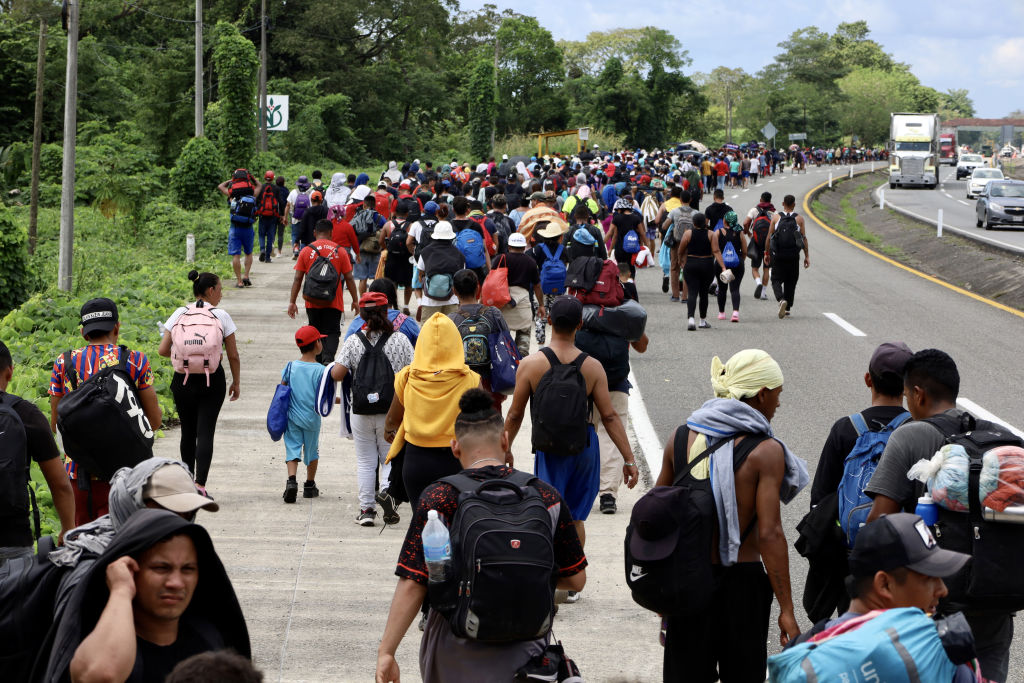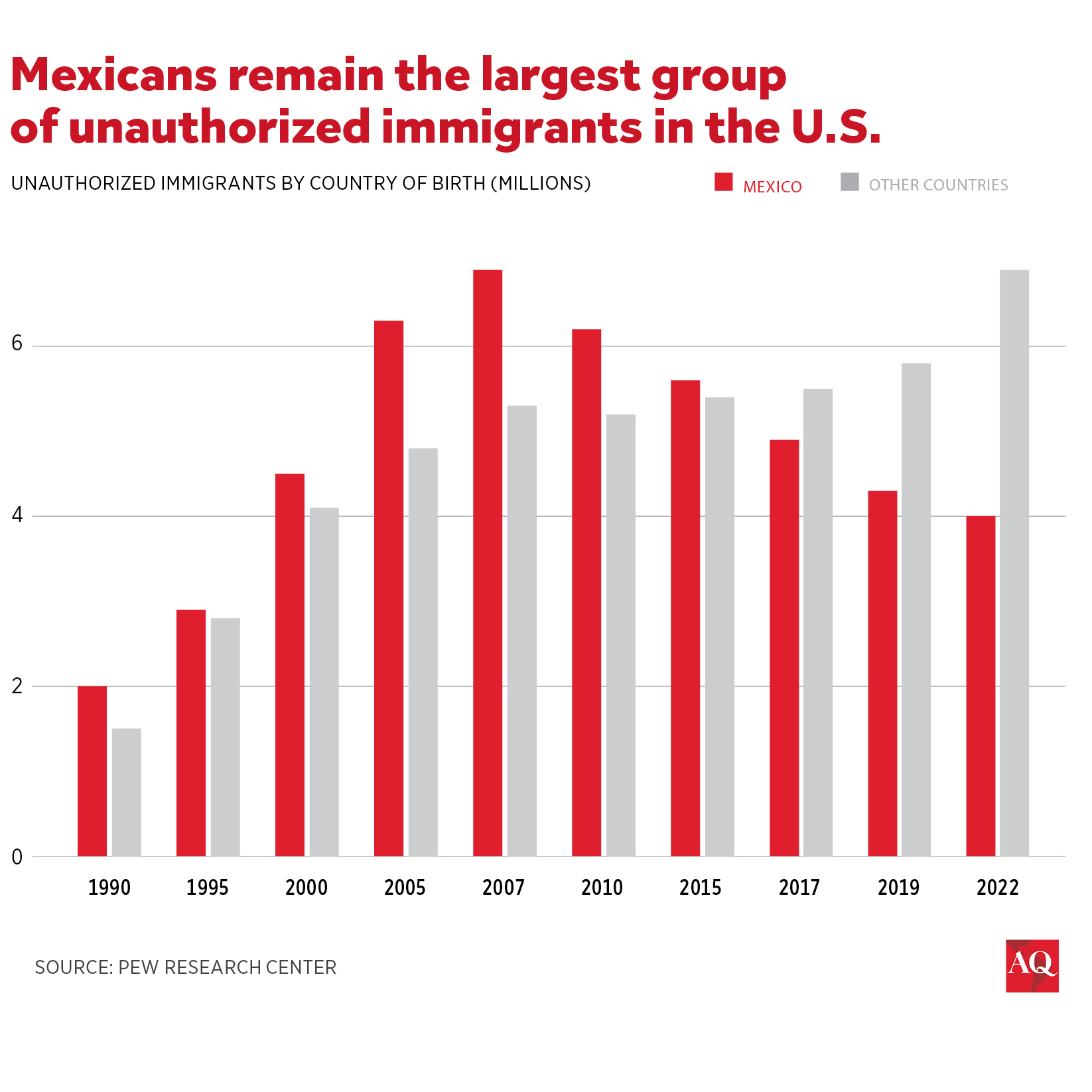Mexico Faces Monumental Challenges with Trump 2.0


MEXICO CITY—There is little doubt that Mexico is among the countries President-elect Donald Trump will target in his first days in power. His recent threat to impose a 25% tariff on goods and services produced south of the Rio Grande and his pledges to initiate massive deportations and dismantle criminal cartels signal an era of change. And none should be more prepared for his comeback than President Claudia Sheinbaum.
While Mexico won’t be alone in facing these trying times—the “Tariff Man” is also threatening Canada and China with levies—the nascent administration of President Sheinbaum needs to act expeditiously to confront the new reality. But on many fronts, Mexico is ill-prepared for the contentious negotiations ahead. The argument that the two countries are “producing together” and therefore that tariffs on Mexico will be counterproductive for the U.S. has apparently gone unheeded in the incoming Trump 2.0 government.
Just yesterday, Trump made clear again that he plans to negotiate trade, immigration, and security simultaneously, treating them as interconnected issues to reset the countries’ relationship. Therefore, Mexico should be ready to present a multidisciplinary strategy for these three areas that combines its best arguments and actions. Migration flows, cartels trafficking synthetic drugs like fentanyl, and the fact that Mexico is the U.S.’s biggest trading partner will no longer be separate tracks of this bilateral relationship.
Reacting to Trump’s announcement, Sheinbaum hinted that Mexico could retaliate by applying its own tariffs on U.S. products. “One tariff would be followed by another in response, and so on until we put at risk common businesses,” Sheinbaum said in her morning briefing. Trade between the two countries reached almost $800 billion last year, so one could assume that money will talk. But things seem to be different with Trump’s comeback.
On immigration, Sheinbaum has stated that her strategy will focus on demonstrating to Trump’s transition team the contribution of Mexican migrants in the U.S., which amounts to $338 billion annually, according to the Mexican government. While she mentioned that her administration is prepared to respond to potential large-scale deportations, she has yet to provide details.
With all things considered, to confront the U.S. complex political and legal backdrop, Mexico needs to build on its institutional framework and apply its best diplomatic strategy. It will face a scenario shaped by hawkish officials and a president who are eager to impose substantial levies on Mexican imports and initiate large-scale deportations reminiscent of President Dwight D. Eisenhower’s notorious 1954 “Operation Wetback.”
The specter of mass deportations
Days ago, Trump confirmed he would declare a national emergency to start the deportations of millions of undocumented immigrants, and just before getting elected, he pledged to invoke the Alien Enemies Act of 1798 to dismantle migrant criminal networks.
Despite this emphasis on enforcement, restriction, and strict interpretation of U.S. immigration law, significant legal, financial, and logistical hurdles will undoubtedly arise, as will widespread concern over potential human rights violations. The U.S. immigration system is already strained by a backlog of 3.5 million pending cases across 56 immigration courts and limited capacity with just 20,000 ICE agents. It seems ill-equipped to manage the scale of deportations envisioned by Trump’s team.
I got a good sense of the U.S. political zeitgeist as I spent Election Day in York, Pennsylvania, engaging with voters who emphasized how pivotal migration is in shaping their views. Some expressed fear of migrants, perceiving them as a national security threat, and supported calls for a completely sealed border. What struck me most were conversations with Latino voters who, somewhat paradoxically, downplayed the potential impact of stricter immigration measures. Many contended that such policies would primarily target “new arrivals” rather than long-established residents like themselves.
While some misleading narratives undermine the contributions migrants make to the U.S., it remains undeniable that immigration is a top priority for the American electorate that backed Trump, and he is likely to take strong action to meet their demands.
The appointments of Tom Homan as “border czar” and Stephen Miller as deputy chief of staff for policy in Trump’s incoming administration—neither of whom will require Senate confirmation—emphasize the former president’s commitment to an aggressive and unwavering immigration policy.
Homan, acting director of ICE during Trump’s first term, will oversee both the southern and northern U.S. borders as well as maritime and aviation security. During the presidential campaign, he warned undocumented immigrants to “start packing,” promising the “largest deportation operation” the country has ever seen. His emphasis on “well-targeted” deportations, while presented as humane, belies the scale of enforcement he intends to implement. This includes deportations of entire families, regardless of whether children have U.S. citizenship. About 4.4 million U.S.-born children under 18 live with an unauthorized immigrant parent.

Miller, who helped shape many of Trump’s most controversial immigration policies, is returning to a prominent position with even greater influence. Miller’s vision for a second Trump term includes a tenfold increase in deportations, targeting over 1 million undocumented immigrants annually. He also advocates for reductions in legal immigration.
Homan and Miller’s combined influence at the helm signals that Trump’s vision for the U.S. border will be executed beginning on Inauguration Day, with minimal concessions, regardless of the legal or economic consequences.
What can be expected?
Since Trump is a media-savvy figure, we can anticipate highly dramatic scenes during his first 100 days in office, with images of large-scale deportations dominating the narrative. We can also expect the reinstatement of programs like “Remain in Mexico,” which forces asylum seekers to wait for their hearings in Mexican border cities, and Title 42, enacted initially during the COVID-19 pandemic to block asylum claims on public health grounds. These measures, which have already strained Mexico’s border towns such as Tijuana, Matamoros and Ciudad Juárez, will likely exacerbate the pressure on already overwhelmed shelters and dire conditions.
The data highlight the scale of Mexico’s challenges. Although the number of undocumented Mexican immigrants has decreased significantly over the past two decades, total migrant encounters at the U.S.-Mexico border surged to a record high of nearly 2.5 million in 2022-23. According to the Pew Research Center, of the estimated 11 million undocumented immigrants living in the U.S., 4 million are Mexican nationals. Furthermore, it is anticipated that the Trump administration may also deport non-Mexican immigrants to Mexico.
The economic consequences of mass deportations would be profound. Last year, Mexican migrant remittances reached a record $63 billion, providing lifelines for millions of Mexican households and serving as a pillar of the national economy, accounting for up to nearly 4.2% of GDP. A significant reduction in these flows due to deportations would deepen poverty and destabilize Mexico’s most vulnerable regions.
Conversely, the U.S. economy also relies heavily on undocumented labor. Construction and hospitality depend on this workforce, and Trump’s deportation plan has also caused panic among American farmers. The American Business Immigration Coalition estimates that the incoming administration’s plans could lead to a decline in agricultural output of between $30 and $60 billion.

Historically, restrictive immigration policies have proven economically counterproductive. The Immigration Act of 1924 sharply curtailed annual immigration, exacerbating labor shortages during the Great Depression. On the other hand, initiatives like the Bracero Program, which facilitated regulated migration, demonstrated the economic benefits of pragmatic immigration policies.
The Mexican side of the border
Last week, Mexico witnessed the departure of a third migrant caravan since the U.S. presidential election, comprising 1,600 individuals who set out from the southern city of Tapachula intending to reach the U.S. border before Trump’s inauguration on January 20. While some participants are Mexican nationals, many more hail from nations such as El Salvador, Guatemala and Colombia. The largest contingent comes from Venezuela, where the deepening political and economic crisis—exacerbated by the fraudulent presidential election—has forced many to flee in search of better prospects.
Mexico is poorly equipped to tackle this growing phenomenon or manage the repercussions of large-scale deportations. The Mexican Commission for Refugee Assistance (COMAR) and the National Migration Institute are already underfunded and overstretched. Both suffer from chronic corruption and lack institutional capacity. Furthermore, the dissolution of the National Migration Institute’s Directorate of International Affairs has left the agency without a specialized body to negotiate effectively with the U.S.
One thing is clear: A surge in deportations, coupled with higher tariffs on Mexican goods as Trump threatens, would destabilize Mexico’s economy, increasing incentives and pressures for migration. Regardless of how high the wall might rise, migration flows would increase, with smugglers emerging as the primary beneficiaries.
Bilateral challenge
The proposed migration policies will further complicate the complex relations between the U.S. and Mexico. Trump’s transactional approach to diplomacy—leveraging issues such as migration, trade and security to exert pressure—will complicate Mexico’s domestic priorities while stretching its limited resources.
The stakes are monumental for Sheinbaum’s nascent administration. While her government has committed to addressing the structural drivers of migration and protecting Mexican nationals abroad, it will likely face compounded humanitarian, economic and security crises that a second Trump presidency would intensify.
It would be naive to assume that Mexico can simply “weather” four difficult years under Trump. This perspective ignores the broader ideological shift within U.S. politics. Trump’s policies reflect a vision that has gained traction within the Republican Party, ensuring that such narratives will likely persist beyond 2028.
Mexico must prepare for a future in which migration, trade and security are inextricably linked in increasingly fraught negotiations. Building institutional capacity, strategic foresight and diplomatic acumen to navigate this complex landscape is not just advisable but imperative for safeguarding national interests in a geopolitically polarized world.
No comments:
Post a Comment